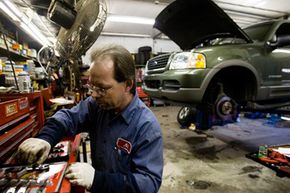How to Remove Brake Line Fittings
If you find your brake line is leaking it must be replaced. Any hydraulic system only works well as a closed system. Air inside the system, or fluid leaking out, can compromise its potential and lead to soft brakes or no brakes at all.
Removing a brake line is as straight forward as removing a bolt from a nut. Because it's simple, however, doesn't make it necessarily easy. Brake fittings are subject to damage by road debris and corrosion from salt, water and galvanic reactions. Most fittings are steel, and while anodized to reduce rust and corrosion, they can (and do) corrode.
Advertisement
The tools you will need are:
- Rust penetrant and lubricant
- Flare nut wrench
- Ratchet and socket
- Open-end wrench
Soak the fitting in question in rust penetrant and wait anywhere from 10 minutes to a full day for the chemicals to work. If the fitting looks particularly bad keep dosing it with generous amounts.
The best tool for removing the fitting is a flare nut wrench. This is an open-ended wrench with five sides for gripping rather than three. Slip the appropriate-sized wrench over the line and slide it down to the nut. Then carefully apply pressure in a counter-clockwise direction.
Sometimes a lot of force is needed to break a fitting free. Be prepared to use a pipe or wrench extender, if possible. Sometimes the nut needs to be worked back and forth, or tightened a little and then loosened before it gives. Sometimes it's just not possible to budge it at all.
If you can't move the fitting in the car, you may have to cut the brake line close to the fitting, remove the component, and attack the fitting out of the car with an open-end wrench, or a deep socket and ratchet. The line will have to be replaced, but this is often cheaper than a new caliper or valve. If a fitting is corroded it's likely the line wasn't doing well either.
Once the component is out of the car the fitting can be heated to help loosen it. This, however, is a possibly dangerous strategy. Brake fluid has a high boiling point, but when reached it can change to a super-heated steam without warning and shoot out of any available crack, pinhole or outlet. Use extreme caution when using heat and take all available safety precautions.
Sometimes it's not possible to salvage the fitting and component and the better part of prudence is to replace the component, fitting and line. Keep reading to find out when this is necessary.
